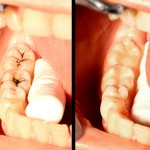
Composite resin restorations are becoming a regular element of restorative dental care. Usually they are photo-polymerised, and polymerization protocols are considered to be one potential factor in the marginal quality of these restorations. The aim of this study was to compare the marginal quality of composite restorations employing two polymerisation protocols, namely regular versus high power.
Patients (aged 19-46 yrs) requiring a restoration due to primary decay with cavity margins in enamel had Class I or Class II restorations in premolars or molars placed incrementally using a micro-hybrid composite. The polymerisation protocol was randomised (by coin-toss) to either regular mode (600-650 mW/cm(2) for 20s) (RM) or high-power (1200-1300 mW/cm(2) for 10s) mode (HPM). Outcomes were measured using the United State Public Health Service (USPHS) criteria and SQUACE criteria at 1 week, 6 months and then annually for 5 years.
- 100 restorations were placed in 50 patients (19 male, 31 female, mean age= 33)
- 36 restorations were in premolars, 64 in molars. There were no drop outs at 5 years.
- Secondary caries, endodontic complications, fractures or chippings were not observed in any of the restored teeth.
- Alfa scores (USPHS) for marginal adaptation (86% and 88% for RM and HPM, respectively) and marginal discoloration (88% and 88%, for RM and HPM, respectively) did not show significant differences between the two-polymerisation protocols (p>0.05).
- Alfa scores (SQUACE) for marginal adaptation (88% and 88% for RM and HPM, respectively) and marginal discoloration (94% and 94%, for RM and HPM, respectively) were also not significantly different at 5th year (p>0.05).
The authors concluded
Regular and high-power polymerisation protocols had no influence on the marginal quality of the micro-hybrid composite tested up to 5 years. Both modified USPHS and SQUACE criteria confirmed that regardless of the polymerisation mode, marginal quality of the restorations deteriorated compared to baseline.
The authors acknowledged support from Ivoclar Vivadent, Schaan, Liechtenstein for the provision of the adhesive and composite materials.
Comment
The trial used a modified split mouth design where the contralateral teeth of premolar or molars of the same arch received a Class I or Class II composite restorations. Randomisation was conducted by the toss of a coin and it is not clear whether the patient of the tooth was the basis of this randomisation. Coin tossing is not considered to be a robust method of achieving randomisation and the data presented shows a surprising balance between the groups. One of the challenges in restorative studies is achieving good follow up in the longer term. Here the authors have done well to achieve 100% follow up at 5 years for what they consider to be a medium-term observation period.
Links
Barabanti N, Gagliani M, Roulet JF, Testori T, Ozcan M, Cerutti A. Marginal quality of posterior microhybrid resin composite restorations applied using two polymerisation protocols: 5-year randomised split mouth trial. J Dent. 2013 May;41(5):436-42. doi: 10.1016/j.jdent.2013.02.009. Epub 2013 Feb 27. PubMed PMID: 23454329.
